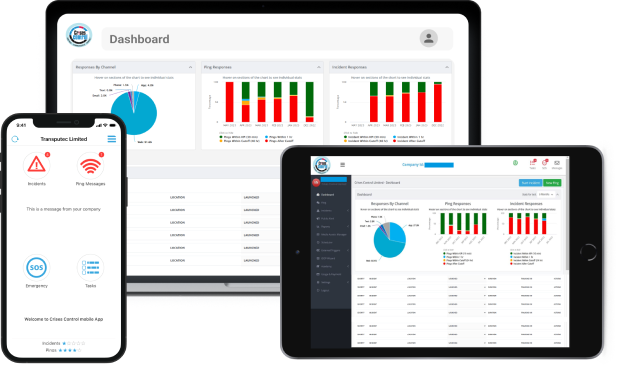Written by Ikram Tassi | Marketing
In an increasingly unpredictable world, the ability to respond swiftly and effectively to crises has become a non-negotiable for businesses. From natural disasters to cyberattacks and operational outages, unexpected events can disrupt operations, harm reputations, and result in significant financial losses.
At the core of an effective response is business continuity software, a technology designed to empower organisations with real-time communication and actionable plans. It provides the tools needed to minimise disruption, safeguard stakeholders, and maintain operational stability.
This blog explores the transformative role of real-time alerts and how business continuity software ensures swift, effective disaster recovery. We’ll also highlight how Crises Control is enabling businesses to stay prepared and resilient in the face of uncertainty.
Why Real-Time Alerts Are Critical for Disaster Recovery
When disaster strikes, timing is everything. A delay of even a few minutes can compound a crisis, causing unnecessary confusion, delays in response, and greater damage to the organisation. Real-time alerts are critical because they ensure information reaches decision-makers and response teams instantly, allowing them to act without hesitation.
What Are Real-Time Alerts?
Real-time alerts are instant notifications that inform recipients of critical events as they occur. They ensure that:
- The right people receive the right information.
- Communication channels remain open, even during high-stress situations.
- Actions can be initiated immediately, reducing downtime and mitigating risks.
Consequences of Delayed Alerts
Delayed alerts can lead to:
- Financial Losses: Prolonged downtime costs businesses thousands—if not millions—of dollars in lost revenue and productivity.
- Operational Disruption: Without timely communication, teams may lack clear instructions, resulting in confusion and inefficiency.
- Safety Risks: Employees and stakeholders face greater risks when they’re not informed promptly.
- Reputation Damage: Poorly managed crises can harm customer trust and tarnish a company’s brand image.
Real-time alerts eliminate these risks, enabling businesses to respond quickly and decisively when it matters most.
How Business Continuity Software Powers Effective Disaster Recovery
Traditional disaster recovery processes often rely on outdated systems and manual workflows, which are prone to delays and miscommunication. Business continuity software modernises these processes by automating alerts, centralising communication, and providing actionable insights.
Core Functions of Business Continuity Software
- Centralised Communication
The software serves as a hub where all crisis-related communication occurs. This eliminates siloed workflows and ensures that everyone is aligned, regardless of their location or role. - Automated Alerts
Business continuity software sends alerts automatically when predefined conditions are met. For instance, if a server fails or extreme weather is detected, the system triggers notifications immediately, removing the need for manual intervention. - Scenario-Based Planning
Organisations can create tailored plans for various crisis scenarios, from IT outages to supply chain disruptions. These plans are stored in the software and can be activated instantly during an emergency. - Multi-Channel Delivery
Alerts are sent via multiple channels—SMS, email, push notifications, and voice calls—ensuring that messages reach recipients regardless of their preferred device or platform. - Two-Way Communication
Real-time feedback from recipients allows organisations to track responses, provide updates, and adapt their strategies as the situation evolves. - Analytics and Reporting
Post-crisis reports provide insights into how effectively the situation was managed, helping organisations refine their processes and improve future preparedness.
The Benefits of Business Continuity Software
Investing in business continuity software yields numerous benefits for organisations seeking to enhance their disaster recovery capabilities.
1. Rapid Response Times
Automated alerts and preconfigured action plans eliminate delays, enabling teams to respond to crises within minutes. This speed is crucial for minimising the impact of disruptions.
2. Improved Coordination
With centralised communication and scenario-based planning, all team members know their roles and responsibilities, reducing confusion and ensuring a unified response.
3. Financial Protection
By minimising downtime and preventing escalation, business continuity software protects organisations from the financial fallout of operational disruptions.
4. Enhanced Safety
Timely alerts and clear instructions safeguard employees, customers, and other stakeholders during emergencies.
5. Long-Term Resilience
The analytics and reporting capabilities of business continuity software allow organisations to learn from each crisis, continuously improving their readiness and resilience.
Key Features of Crises Control’s Business Continuity Software
Crises Control is at the forefront of business continuity solutions, offering a platform designed to address the unique challenges organisations face during crises.
1. Instant Multi-Channel Alerts
Crises Control ensures that critical messages are delivered through multiple channels, including SMS, emails, push notifications, and voice calls. This redundancy ensures that no alert goes unnoticed, regardless of device or location.
2. Scenario-Based Action Plans
The platform allows organisations to create and store tailored action plans for various types of crises. These plans are automatically triggered alongside alerts, ensuring a seamless transition from notification to action.
3. Geo-Targeted Communication
Crises Control’s geo-fencing feature ensures that alerts are sent only to those in the affected area. This reduces unnecessary panic and ensures that resources are allocated efficiently.
4. Two-Way Feedback Loop
Recipients can acknowledge alerts, share their status, and provide updates in real time. This feedback loop enhances situational awareness and helps teams adapt their response strategies.
5. Post-Crisis Reporting
Comprehensive analytics provide insights into response times, alert delivery, and team performance. These reports are invaluable for refining disaster recovery plans and improving future outcomes.
How Crises Control Addresses Common Challenges
Many organisations struggle with outdated crisis management practices, which often involve:
- Delayed Communication: Manual processes are slow and error-prone.
- Fragmented Systems: Disparate tools and platforms create inefficiencies.
- Lack of Preparedness: Without predefined plans, teams are forced to improvise during crises.
Crises Control addresses these challenges by providing a unified, automated solution that integrates real-time alerts with actionable plans. The platform’s user-friendly design ensures that teams can focus on managing the crisis rather than navigating complex software.
Building a Culture of Preparedness
Investing in business continuity software like Crises Control isn’t just about technology; it’s about creating a culture of preparedness. Organisations that prioritise crisis management demonstrate their commitment to:
- Employee Safety: Protecting the well-being of their workforce.
- Customer Trust: Ensuring reliable service even during disruptions.
- Operational Stability: Minimising downtime and maintaining productivity.
Preparedness is a mindset that permeates every aspect of an organisation, from leadership to frontline employees. With the right tools and training, businesses can face any challenge with confidence.
The Future of Business Continuity and Disaster Recovery
As technology continues to evolve, so too does the field of disaster recovery. Business continuity software is increasingly incorporating advanced features such as AI-driven analytics, predictive modeling, and real-time monitoring. These innovations are empowering organisations to:
- Identify potential risks before they escalate.
- Optimise their response strategies with data-driven insights.
- Enhance collaboration through intuitive, user-friendly interfaces.
Crises Control remains at the forefront of these advancements, ensuring that businesses are equipped to navigate the challenges of tomorrow.
Conclusion: Be Ready for Anything with Crises Control
In an unpredictable world, readiness is the foundation of resilience. Real-time alerts and actionable plans are no longer optional—they’re essential for effective disaster recovery. Crises Control’s business continuity software provides the tools you need to respond swiftly, recover quickly, and protect your organisation’s future.
Don’t wait for a crisis to test your preparedness. Contact us today for a free demo and discover how Crises Control can help your business stay ready, no matter what comes your way.
Request a FREE Demo

